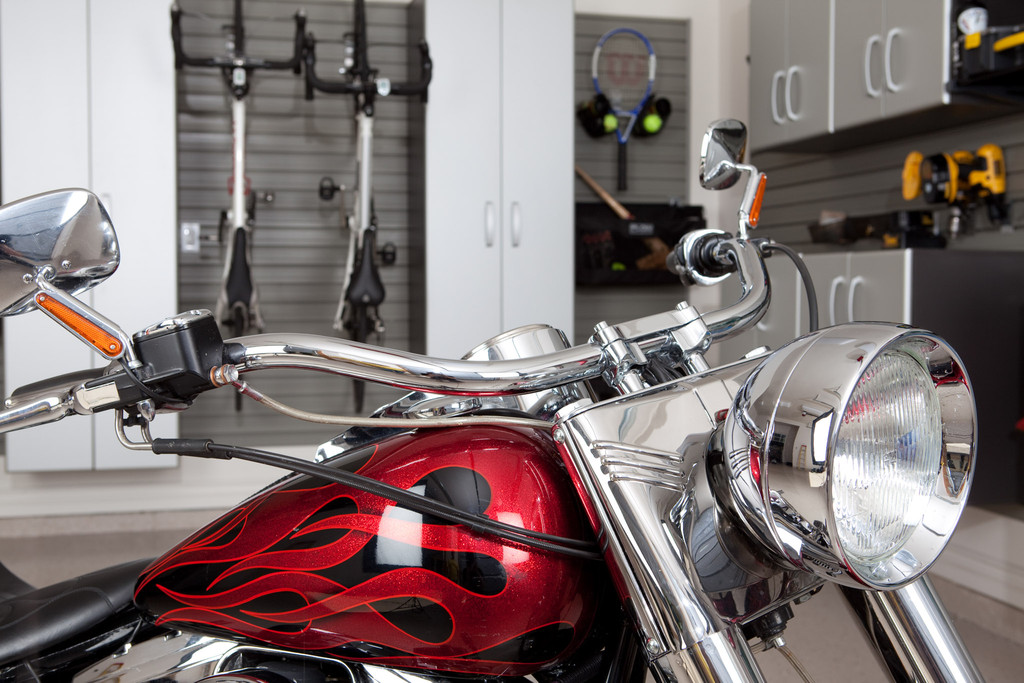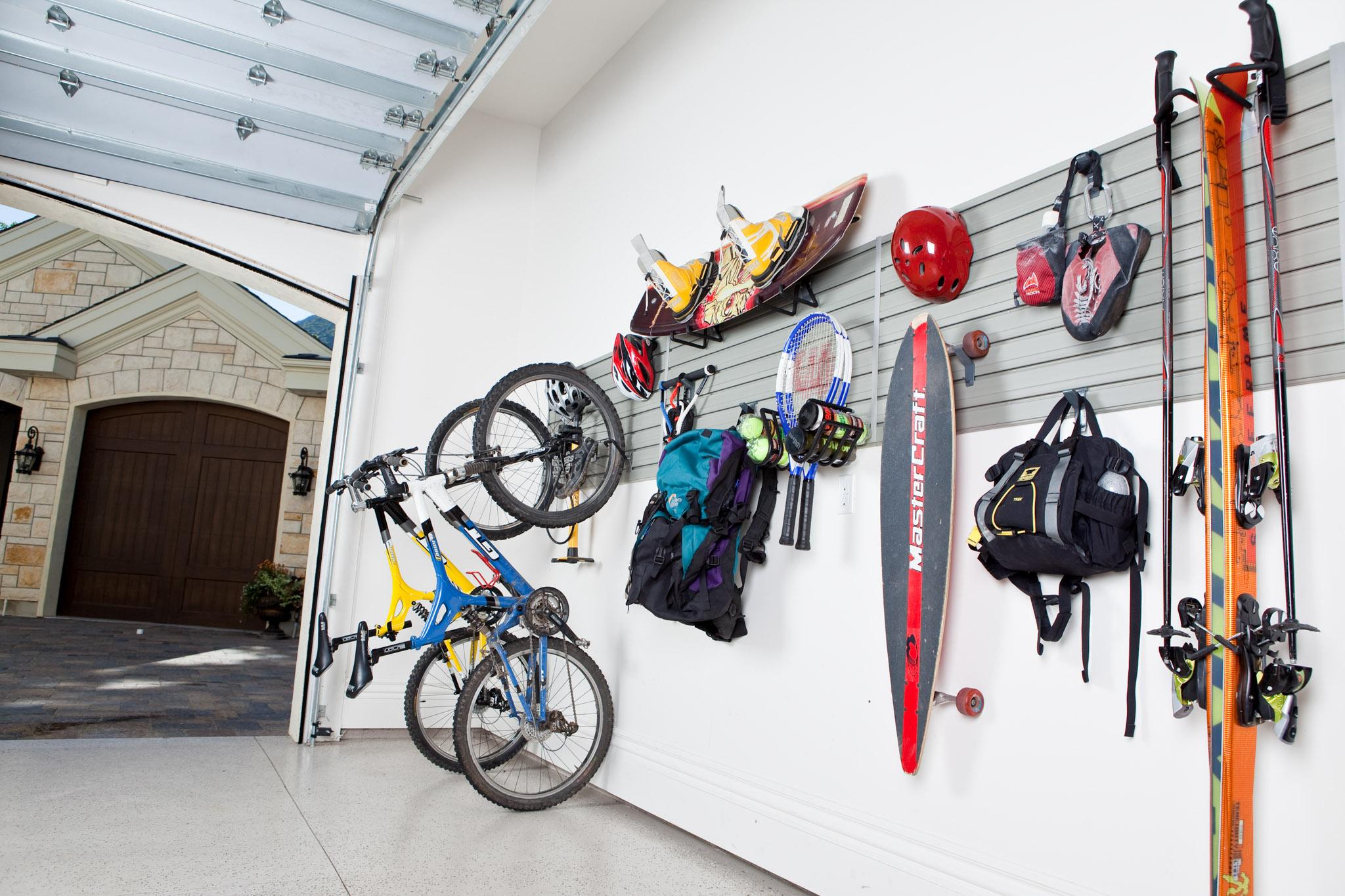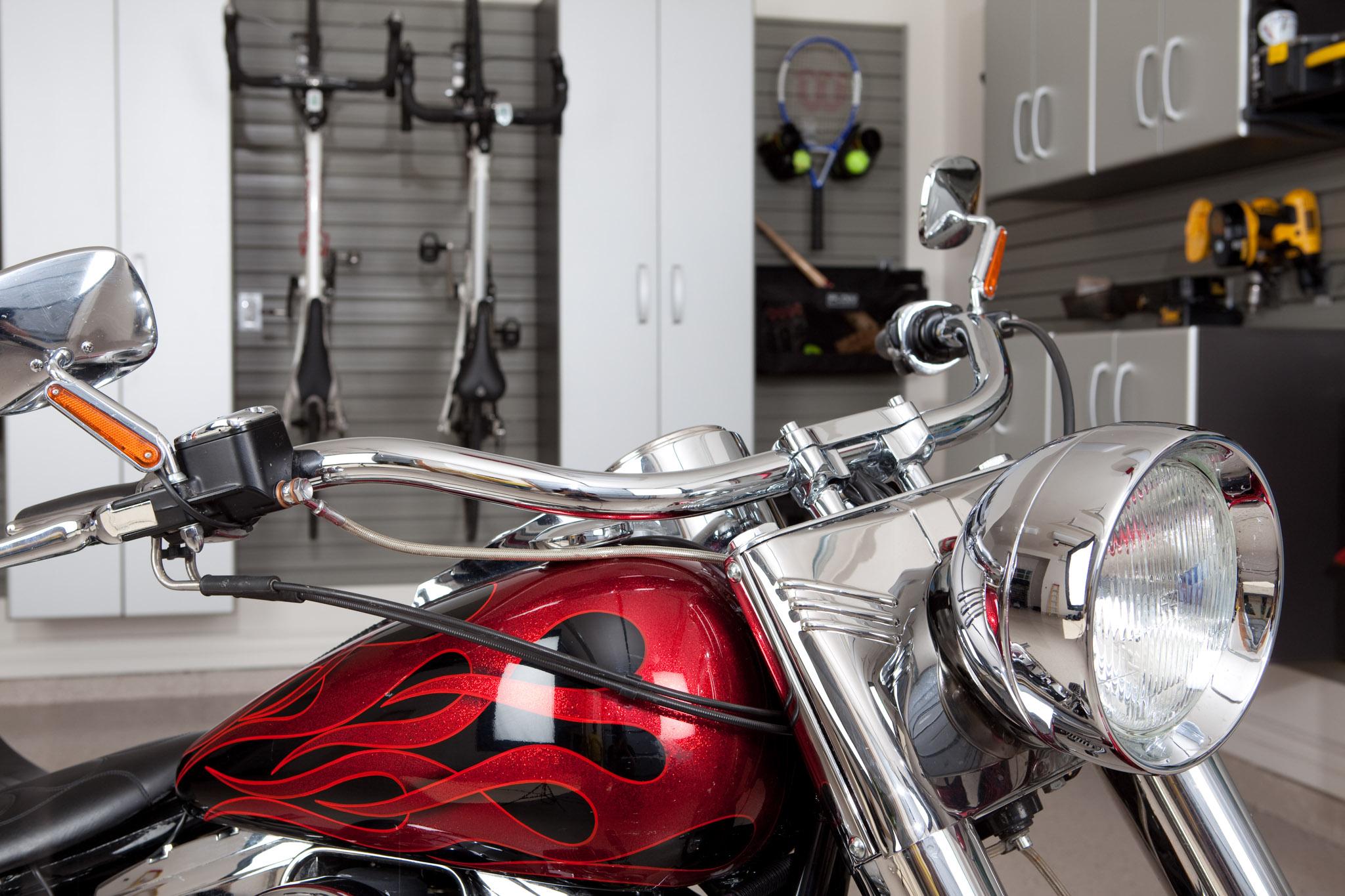The garage houses a lot of our important tools and toys, but those items can add up fast. When it comes to garage storage, conserving space and using your garage wisely is always a challenge, and big, awkwardly-sized items make it that much more difficult to do. Are there a few items that you just can't quite find a place for? Those bulky objects get in our way too, so we found the best solutions for giving these items a good home. There are a few options for every skill level and budget, so don't rule out finding a better, more organized solution for any of these items.
1. How to Store a Lawn Mover
Can You Store a Lawn Mower Vertically?
Lawn mower garage storage can take up a lot of room. If you're extremely limited on storage space, you may be wondering if it would hurt to store your lawn mower vertically. Unless your machine was built for vertical storage, we don't recommend it. Vertical lawn mower storage can cause fuel and oil to drip into the engine, which is exactly where you don't want it to go. Check your manufacturer storage recommendations to find out if your lawn mower was built for vertical storage. If not, then you should always keep it flat on the ground.
How Do You Store a Lawn Mower Outside?
If you absolutely must, you can store your lawn mower outside, but it isn't recommended. These machines aren't weather-proof, so if you want to keep your mower in good condition for years to come, you're going to want to store it indoors. The best place for lawn mower storage is somewhere dry and protected from the elements, such as a garage or shed. If you have no other choice but to store it outside, keep it elevated above the ground and covered with a durable tarp. If you can, keep it under a covered gazebo or awning, so as to add a little extra shelter against rain, snow, etc. While you cover your mower, don't forget to allow for proper air flow. Trapping it inside a stuffy cover with no ventilation can easily lead to rust, mold, and mildew.
How Do You Store a Lawn Mower for the Winter?
As we've mentioned, it's always best to store your lawn mower indoors—especially during cold, wet seasons. Before you tuck it away for a long winter, it's also just as important to winterize the machine. Use these tips to protect and preserve your mower before you put it to rest for an entire season.
- If you have a gas-powered mower, get some fuel stabilizer and add it to the fuel tank. Run the engine for 5-10 minutes to help it circulate.
- For electric mowers, take out the battery and charge it completely before storage.
- Empty the fuel tank and turn the mower on until it stops running. Keep turning it on until it no longer starts, just to make sure you've cleared out all the fuel.
- Clean the deck by tilting the mower on its side and spraying the deck thoroughly with the garden hose on full blast. If particularly dirty, give the deck a good scrub with soapy water and rinse well.
- Clear away any debris or gunk around the engine and wipe down the exterior.
- Lubricate your lawn mower by following the instructions provided in the user manual.
- Replace any damaged or clogged air filters.
- Tighten loose fasteners.
- Follow any additional winterization recommendations provided in the user manual. These will vary depending on the type of engine.
2. How to Store a Bicycle
Bicycles are difficult to store partially because they are large, oddly-shaped items, but also because there are so many of them. A family of four may have five or six bikes that fit the growing kids at different stages, even an individual can own a handful of bikes for different terrain. The goal with bicycle storage is to take advantage of their thin frame by stacking them. Multi-bike racks, hooks, and floor stands make it easy to stack two to four bikes on top of each other with ease. If you use bikes regularly and have the floor space, a stand makes the most sense. If you don't have extra space and use bikes sparingly, go for the rack. There are some other options if you want to be more frugal or technical. A large nail and bungee cord can easily be used to store a single bike on the wall. Or you can hoist bikes overhead and take advantage of the extra ceiling space in your garage. This quick video will show you how to do either option.
3. Storing a Wheelbarrow
Can you think of a piece of gardening equipment more awkward than a wheelbarrow? These handy tools serve an essential purpose in your tool arsenal, but storing them is never easy. Again, this is an item that would be great to store in an outdoor shed if you have one or have space to build one. If that isn't an option, you'll want to find ways you can get this tool off the floor. One option is wall storage. There are various hooks and clips that have been designed to hang your wheelbarrow on the wall. If wall storage isn't an option, you can also make a lift that will hoist your wheelbarrow overhead.
4. Motorcycle Storage
Motorcycles can be difficult to store because they take a lot of maintenance, most of which you may not know. When storing your motorcycle for the winter months, make sure to drain all the gas. Gas rots, so you need to drain it or use a fuel stabilizer to keep it from going bad when your motorcycle isn't in use. When you cover your motorcycle, make sure you use a breathable material. Just using a plastic tarp that doesn't breathe can trap dust and moisture inside, causing the metal to rust. You also want to make sure the location you store your motorcycle is dark. Even the smallest amount of sunlight can fade your shiny paint job. If your garage has a window, keep the motorcycle far from it.
5. How to Store a Refrigerator
Whether you need a second fridge for overflow groceries or bulk food storage, the garage seems like a great place to put it. But, unfortunately, the opposite is true. Refrigerators are directly affected by the surrounding temperature. Which means the fridge will have to work extra hard to keep your food cold in the summer, burning up energy and blowing up your monthly bill. In the winter, most fridges will stop cooling food when temperatures drop below 60 degrees, meaning your food could inadvertently go bad after a series of chilly days. Keep your extra fridge in a more temperature-controlled space. The basement or storage space under the stairs is a better option.
6. How Do You Prepare a Snowblower for Storage?
The importance of winterizing machinery is fairly common knowledge; it just makes sense to protect metal working parts from the cold and wet. However, preparing winter-use machinery for summer storage is just as important. Use these tips to preserve the condition of your snowblower before you add it to your collection of large item storage.
- Add fuel stabilizer to the gas tank if you've got a lot of fuel left after the final use.
- Drain the gas tank into a safe storage container. If you don't care to save the fuel, you can run your machine until the remaining gas has been used.
- Seal your engine according to user manual instructions. This usually involves removing the spark plug, adding oil, and lubricating the piston and cylinder wall.
- Give your snowblower a thorough wipe down with a clean wet rag to prevent salt buildup and grime.
- Lubricate your snowblower according to manufacturer recommendations.
- Use a ventilated snowblower cover for an added layer of protection during off-season storage.
- Snowblowers require a decent amount of floor space, as they can't exactly be mounted on the wall. If you don't have enough room in your garage, consider storing the snowblower in a shed—just make sure you keep it off the ground and covered.
7. Snowmobile Storage Ideas
Snowmobiles are another common piece of large item storage that can be difficult to find a place for during off-seasons. Since these machines are so massive, finding enough storage space to keep them protected during the summer seems impossible for many. If you don't have any room in your garage for your snowmobiles, you can rent a personal storage unit, keep them in a shed (preferably positioned in the shade), house them in an enclosed trailer, or on a trailer bed. Wherever you choose to keep your snowmobile(s), make sure you adhere to the following tips for off-season storage.
- Keep the machines elevated, even if you just place them on cinder blocks.
- Always use covers that are reliable and well-ventilated.
- If possible, store your snowmobiles in a place that won't get extremely hot in the summer.
- Always clean, polish, lubricate, and prepare your snowmobiles for long-term storage.
- Remove the batteries and keep them in a safe place indoors.
Additional Large Item Storage
Lawn mower garage storage isn't the only problem people struggle with. There are so many different large items that need a proper place to preserve their condition and keep them out of the way. Use these tips for additional large item storage to keep your garage organized and free of tripping hazards.
- Store ladders on mounted hooks or tracks to prevent them from tipping over. You can also suspend them horizontally from the ceiling with a simple hoist.
- For snowboards and skis, opt for a simple sports track that can hold your gear vertically or horizontally against the wall.
Optimal Garage Storage
With the right garage storage system, you can create enough space in your garage to store almost anything in there. Seasonal sports gear, tools and equipment, bins of seldom-used items, holiday decorations, gardening supplies, you name it. All you need is the right system. For optimal garage storage, we recommend you make liberal use of the walls. Mount cabinets, shelving, brackets, hooks, tracks, and whatever else you need to free up some floor space. Before you mount any shelves or hooks, consider who will be reaching for the items most often. If you're installing a sports rack for your kids' equipment, you don't want to set it too high up so they can't reach it. At the same time, you'll need to make sure that wide or bulky items (like bikes) aren't going to be in the way of your vehicles.


